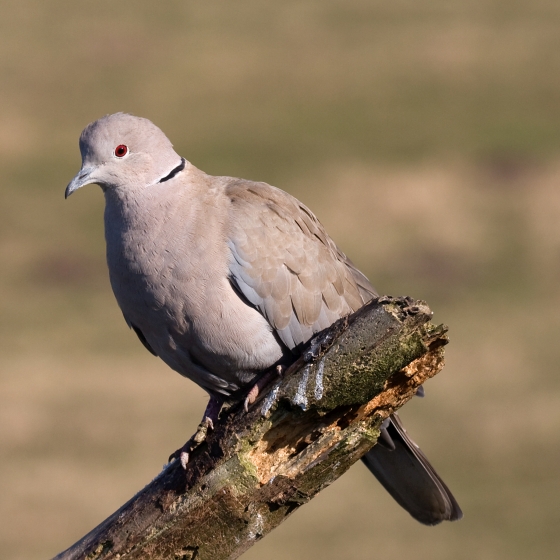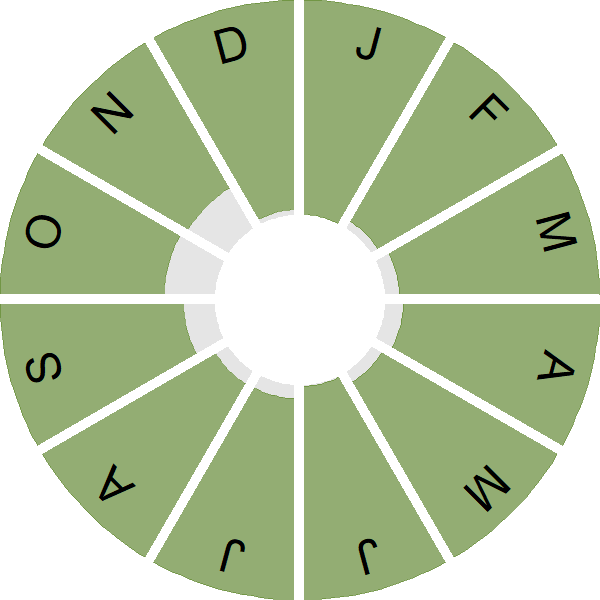Collared Dove

Introduction
Collared Dove is now a familiar bird, occupying a range of open lowland habitats, but only began its colonisation of Britain in the 1950s.
Given favourable weather conditions, Collared Doves may nest in any month of the year. Despite the very small number of eggs laid for each nesting attempt, which is invariably two, multiple nesting attempts may be one reason why the species has been so successful.
Despite the dramatic long-term increase in numbers and range, a decline in Collared Dove populations was noted from 2005 onwards, and likely linked to the emergence and spread of finch trichomonosis.
- Our Trends Explorer gives you the latest insight into how this species' population is changing.

Key Stats
Identification
ID Videos
This section features BTO training videos headlining this species, or featuring it as a potential confusion species.
Collared & Turtle Dove
#BirdSongBasics: Collared Dove and Woodpigeon
Songs and Calls
Song:
Flight call:
Status and Trends
Conservation Status
Population Change
Collared Dove abundance has increased rapidly since the species first colonised Britain in 1955. From just four birds known to be present in that year, the population was put conservatively at 15,000-25,000 pairs by 1970 (Hudson 1972). The CBC index showed an almost exponential rise as colonisation continued during the early 1970s, but had levelled off by about 1980 only to rise again from the early 1990s. The early years of BBS showed this increase, but numbers are now similar to the mid-1990s following a recent downturn, apart from in Northern Ireland, where BBS records a strong increase. The BBS map of change in relative density between 1994-96 and 2007-09 indicates that increase at the time was strongest in East Anglia and Kent and that decreases have occurred in eastern Scotland and in small pockets of England. There has been an increase across Europe since 1980 (PECBMS: PECBMS 2020a>).
Distribution
Since first colonising Britain in the 1950s, Collared Doves have become a widespread species, breeding and wintering across Britain & Ireland, with the exception of higher ground such as the Scottish Highlands and remote treeless expanses of bogs or flows. Abundance is greatest in the east of England, in the Fens, and near other concentrations of arable or horticultural land use such as in northwest England.
Occupied 10-km squares in UK
2007/08–10/11
or view it on Bird Atlas Mapstore.
2008–11
or view it on Bird Atlas Mapstore.
European Distribution Map
Distribution Change
The Collared Doves range in southeast Britain has remained relatively stable since the 1970s. Elsewhere, there are ongoing gains across north and western Britain and most of central and western Ireland.
Change in occupied 10-km squares in the UK
from 1981–84 to 2007–11
or view it on Bird Atlas Mapstore.
from 1968–72 to 2008–11
or view it on Bird Atlas Mapstore.
Seasonality
Collared Doves are widely recorded throughout the year.
Weekly pattern of occurrence
The graph shows when the species is present in the UK, with taller bars indicating a higher likelihood of encountering the species in appropriate regions and habitats.

Habitats
Breeding season habitats
Relative frequency by habitat
The graph shows the habitats occupied in the breeding season, with the most utilised habitats shown at the top. Bars of similar size indicate the species is equally likely to be recorded in those habitats.

Movement
Britain & Ireland movement
Foreign locations of birds ringed or recovered in Britain & Ireland
Dots show the foreign destinations of birds ringed in Britain & Ireland, and the origins of birds ringed overseas that were subsequently recaptured, resighted or found dead in Britain & Ireland. Dot colours indicate the time of year that the species was present at the location.
- Winter (Nov-Feb)
- Spring (Mar-Apr)
- Summer (May-Jul)
- Autumn (Aug-Oct)

European movements
EuroBirdPortal uses birdwatcher's records, such as those logged in BirdTrack to map the flows of birds as they arrive and depart Europe. See maps for this species here.
The Eurasian-African Migration Atlas shows movements of individual birds ringed or recovered in Europe. See maps for this species here.
Biology
Productivity and Nesting
Nesting timing
Egg measurements
Clutch Size
Incubation
Fledging
Survival and Longevity
Survival is shown as the proportion of birds surviving from one year to the next and is derived from bird ringing data. It can also be used to estimate how long birds typically live.
View number ringed each year in the Online Ringing Report.
Lifespan
Survival of adults
Biometrics
Wing length and body weights are from live birds (source).
Wing length
Body weight
Ring Size
Classification, names and codes
Classification and Codes
- Order: Columbiformes
- Family: Columbidae
- Scientific name: Streptopelia decaocto
- Authority: Frivaldszky, 1838
- BTO 2-letter code: CD
- BTO 5-letter code: COLDO
- Euring code number: 6840
Alternate species names
- Catalan: tórtora turca
- Czech: hrdlicka zahradní
- Danish: Tyrkerdue
- Dutch: Turkse Tortel
- Estonian: kaelus-turteltuvi e. pargi-turteltuvi
- Finnish: turkinkyyhky
- French: Tourterelle turque
- Gaelic: Calman-coilearach
- German: Türkentaube
- Hungarian: balkáni gerle
- Icelandic: Tyrkjadúfa
- Irish: Fearán Baicdhubh
- Italian: Tortora dal collare
- Latvian: gredzenubele
- Lithuanian: pietinis purplelis
- Norwegian: Tyrkerdue
- Polish: sierpówka
- Portuguese: rola-turca
- Slovak: hrdlicka záhradná
- Slovenian: turška grlica
- Spanish: Tórtola turca
- Swedish: turkduva
- Welsh: Turtur Dorchog
Research
Causes of Change and Solutions
Causes of change
There is little evidence available relating to the drivers of the increase in this species but it appears to have been able to fill an empty niche and exploit the intermittent seed resources available in gardens and may also benefit from milder winters. Given the long-term rise, there is no baseline of 'stability' against which to compare demographic rates that might be causing a change but increases in nesting productivity have reversed during the recent period of decline.
Further information on causes of change
There are very few studies from the UK looking at the causes of population change in Collared Dove. Apart from clutch size, the demographic data show a curvilinear trend, with fledglings per nesting attempt peaking during the 1980s and 1990s but now falling back to earlier levels (see graphs above). The species appears to have filled a previously empty niche, perhaps because it is able to adapt to new environments, and it is commonly found in gardens, exploiting the intermittent seed resources available. It may also benefit from milder winters, which the species can exploit with its long breeding seasons. However, evidence for this is anecdotal.
Robertson (1990) measured high productivity and a long breeding season in rural Collared Doves in Oxfordshire and suggested that these were made possible by feeding on superabundant, predictable and persistent supplies of commercial crop seed in and around farmyards. However, there is little evidence based on specific analyses to support this.
There is evidence that the recent slowing of population increase may be due to increasing numbers of grey squirrels, as Newson et al. (2010b) provided good evidence from nest record data which showed a positive relationship between nest failure at the egg stage and squirrel abundance. They may also have been approaching the saturation of their niche. Whilst this species is affected by trichomonosis, the outbreak first noted in 2006 which has severely affected Greenfinch populations is not thought to be the primary cause of the current downturn in Collared Dove abundance, as there have been no increases in reports of diseased birds (B.Lawson, pers. comm.). Population trends have been different in Scotland but the reasons for this are unclear.
Information about conservation actions
The Collared Dove increased rapidly in both abundance and range after colonising the UK in the late 1950s, but a downturn has occurred since the early years of the current century. In the absence of clear evidence confirming the reasons for this downturn, conservation requirements are unclear. It is possible that the recent changes in breeding productivity observed are partly related to density dependent effects and may not be of particular conservation concern; however, the short-term declines are close to prompting alerts. This suggests trends should continue to be carefully monitored and that action may be required for this species in future.
The impact of grey squirrels has also been suggested as a potential factor (Newson et al. 2010b); hence control of grey squirrels is another conservation action which could potentially benefit the Collared Dove.
More Evidence
More evidence from Conservation Evidence.com
Partners
Citing BirdFacts
If you wish to cite particular content in this page (e.g. a specific value) it is best to use the original sources as linked in the page. For a more general citation of the whole page please use: BTO (20XX) BirdFacts Species: profiles of birds occurring in the United Kingdom. BTO, Thetford (www.bto.org/birdfacts, accessed on xx/xx/xxxx).

